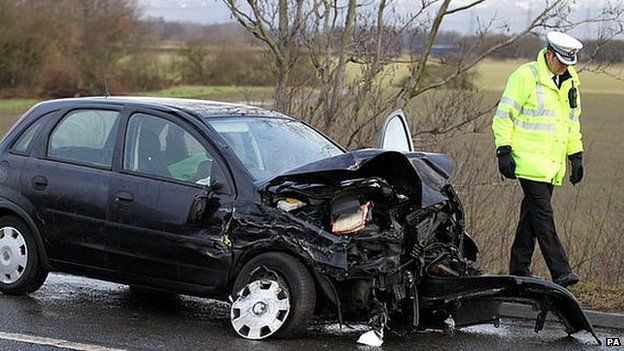Speed awareness: Are courses out to make money?
- Published

It is 12 years since the speed awareness course was launched in England and new figures reveal road deaths have more than halved in that time. But many drivers nabbed at a few miles per hour over the limit feel they are driving safely and the victims of a "money-making" racket. I was one of them.
When I was caught doing 35mph in a 30 zone and had to pay £88 to go on the course, I was fuming. But after three hours in the classroom my attitude had changed.
I was staggered at the number of road markings and signs I did not know. We were shown clips of a car going at 30mph and had to spot 20 potential hazards during a journey lasting a few minutes - I got 13.
Not everyone is as easily won over though. Speed awareness course instructor John Hamilton suffered broken ribs in the classroom a few years ago when he was attacked by a disgruntled motorist.
He says he can deal with aggro, but finds it more frustrating when drivers are resolute they will not get anything out of the course.
"Recently I had a man in his 70s stand up and say he'd never worn a seatbelt," he says. "About 5% of those who attend won't engage or think the course is a money-making racket.
"I've even had a few fall asleep. But most of the time you get brilliant feedback and drivers say the course has made them think."
Mr Hamilton, who does courses throughout the north-east England and Yorkshire, does not hesitate when I ask him my burning question: "Have you ever been done for speeding?"
"Yes," the 51-year-old replies: "I was caught twice about six weeks apart, 20 years ago."
He says he did not really care at the time. But since he became an advanced driver and more aware of the road death statistics he has been passionate about spreading the safe-driving message.
As well as cameras, Mr Hamilton believes there should be more visible deterrents such as police patrols. He also believes that learning to drive at 17 years of age should not be a life-long qualification, but a skill to be updated and retested.
The statistic that many drivers remember after the course is that a pedestrian hit by a car travelling between 30mph and 40mph is five times more likely to die than someone hit by a car travelling at below 30mph.
Not everyone is eligible for a course, though. There is a certain amount of leeway. Doing 42mph in a 30mph zone would be the maximum. Go faster and points on the licence are imposed.
Mr Hamilton said few people were stubborn enough to take points rather than do the course, although one of the few he knows was his own mother.
She was in her 70s and caught speeding while taking a friend to hospital. "She said she was too old to sit in a classroom for four hours - I had some sympathy."
Road deaths halved in 12 years
- In 2003 (when course was launched) 3,508 people died on the roads
- In 2013 (the latest figures - they will next be updated in July) 1,713 were killed.
- Exceeding the speed limit was a factor in 12% of fatal road accidents in 2013
The first speed awareness course was launched in Lancashire in 2003, followed by Thames Valley the following year. Most police forces offer it - 39 out of 42 in the UK - but there are exceptions including Wiltshire and Sussex, while Cleveland Police only began offering it in 2008. The courses are not offered to drivers in Scotland.
Many authorities use private companies, such as AA DriveTech or TTC2000, to provide courses.
The Association of Chief Police Officers said safer cars, as well as the speed course, had helped reduce deaths.
There are 45 speed cameras in Northumberland, but only 12 - a quarter - are switched on, the BBC has learned. So claims it is a money-making racket are denied by course providers - if this was the case, they argue, they would all be switched on to catch as many people as possible.
However, there are many drivers who are opposed to the cameras.
Claire Armstrong, co-founder of Safe Speed, a campaign against speed cameras, believes the way in which a car is being driven, rather than how fast it is going, should be the focus of road safety.
Drivers over the limit can be perfectly safe because of their skill and awareness of the road conditions, she says.
She also believes it is a dangerous distraction for drivers to focus on the camera and their speed dial when they should be looking at the road.
"The survival instinct is self-preservation - if a driver sees a hazard they will start to slow down, so the speed they are going is not usually the impact speed," she says.
She believes distraction and inattention are the two main causes of accidents, not speed.
"The message that speeding kills is too simplistic."
- Published24 June 2011
- Published18 November 2012
- Published18 November 2012
- Published2 November 2011
- Published1 November 2010